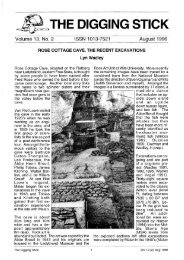~_o THE DIGGING STICK - The South African Archaeological Society
~_o THE DIGGING STICK - The South African Archaeological Society
~_o THE DIGGING STICK - The South African Archaeological Society
Create successful ePaper yourself
Turn your PDF publications into a flip-book with our unique Google optimized e-Paper software.
far more widespread in Neolithic times: their preservation in western Ireland is due in part to being<br />
buried in peat, and in part to the raw materials (stone rather than, say, hedgerows) used in their<br />
development. Excavations continue, and the fields are proving to be more extensive than previously<br />
thought and not grouped in discrete clusters.<br />
PHOENICIAN SHIP ON <strong>THE</strong><br />
WOL TEMADE FLATS?<br />
Dear Editor,<br />
It is an interesting thought that<br />
the remains of an ancient<br />
vessel from the Mediterranean<br />
may lie here at the<br />
Cape, but it will need more<br />
than radiocarbon dating and<br />
a survey of local history to<br />
arouse interest among the<br />
general, non-political, public<br />
[Wilson, <strong>The</strong> Digging Stick<br />
August 1993; Hromnick, <strong>The</strong><br />
Digging Stick April 1994].<br />
Firstly, has the species of<br />
wood from which the finds<br />
were made been positively<br />
identified? I know that this<br />
can be done at the Jodrell<br />
Laboratory in Kew Gardens;<br />
and expert opinion may also<br />
be available in <strong>South</strong> Africa.<br />
If the wood is found to be exotic,<br />
such as Cedar of Lebanon<br />
(Cedrus libani), then we are<br />
getting somewhere, because<br />
this was an item of trade as<br />
early as the Egyptian Old Kingdom,<br />
and certainly used fo r<br />
oars in the boat buried near<br />
the Pyramid of Cheops about<br />
2600 BC. * Very much secondly<br />
(for this would only<br />
show the timber to be old, and<br />
from a ship) are the pieces<br />
worked into recognisable<br />
shapes for ship construction,<br />
and by the correct tools? I<br />
mean fragments of strakes,<br />
thwarts, trenails, etc., shaped<br />
by adze and with holes bored<br />
by an auger. A marine archaeologist<br />
could check out these<br />
factors by sight and touch.<br />
Yours sincerely,<br />
Captain Steven Banks RN<br />
FRSA<br />
* Johnstone, P. 1980. <strong>The</strong> seacraft<br />
of history. Routledge and Kegan<br />
Paul. pp 72, 81.<br />
Editor's comment: See article by Tim Hart and Oave Halkett (this issue). Readers might be<br />
interested in an article by Oavid Gibbins in the Illustrated London News (Christmas 1993:<br />
Vol281 (7116):72-73) on the excavation of a Bronze Age wreck off the coast of Turkey. Dating<br />
from the late 14th/early 13th century BC, when the Mycenaean Greek civilization was<br />
flourishing, its study is demonstrating unexpectedly early foundations of a Mediterranean maritime<br />
tradition. '<strong>The</strong> techniques of ship construction, the hull size, the types of cargo goods and<br />
receptacles, and the merchaot's weighing equipment would all have been familiar to Roman and<br />
Byzantine traders almost 2000 years later.' <strong>The</strong> 12 tonnes of cargo and stone ballast being<br />
excavated provide unique insights into Bronze Age trade pattems. Of interest to <strong>African</strong>ists is that<br />
amongst these items are logs of <strong>African</strong> blackwood ebony, probably from upper Egypt, while<br />
other exotic raw materials include whole sections of elephant and hippopotamus tusk, several hippo<br />
teeth, and five ostrich eggshells, 'perhaps intended as the bowls of cups to be reinforced<br />
with silver or gold'.<br />
FROM <strong>THE</strong> EDITOR<br />
To Or Margaret Avery we owe enormous gratitude for the way she has shaped this newsletter<br />
and brought it to new heights during her five and a half year spell as editor.<br />
At the recent <strong>South</strong>ern <strong>African</strong> Association of Archaeologists' Conference, emphasis was g i v en to<br />
the need for popularizing the methods and findings of archaeology in <strong>South</strong> Africa. As<br />
museums continue to integrate archaeology into their education programmes (see Lita<br />
Webley's article, this issue), some exciting new ventures, such as comic-strip archaeology, were<br />
outlined. <strong>The</strong> Digging Stick, for its part, aims to keep you ever informed of local<br />
developments in archaeology.<br />
We continue to rely on your support by way of contributions and suggestions. Please send<br />
material to: Oavid Morris, McGregor Museum, P.O. Box 316,8300 Kimberley, <strong>South</strong> Africa. Fax:<br />
0531-29311.<br />
Membership enquiries: <strong>The</strong> Assistant Secretary, P.O. Box 15700, 8018 Vlaeberg.<br />
Editor: David Morris. Published by the <strong>South</strong> <strong>African</strong> <strong>Archaeological</strong> <strong>Society</strong>, P .0. Box 15700, 8018 Vlaeberg, <strong>South</strong><br />
Africa. Word-processed by D. Morris and S. Mngqolo and typeset by D. Coetzee, courtesy of the McGregor Museum.<br />
Printed by Swift Print, Kimberley.<br />
<strong>The</strong> Dififiinr; Stick 11 (2) 12 ISSN 1013-7521






